Exploring Burj Khalifa: Height, Innovation, and Culture
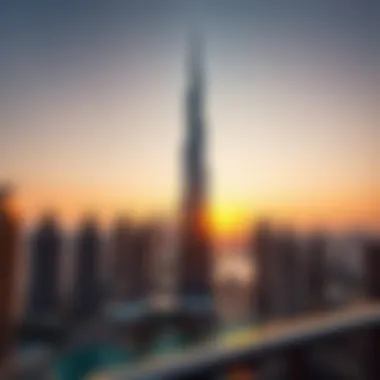
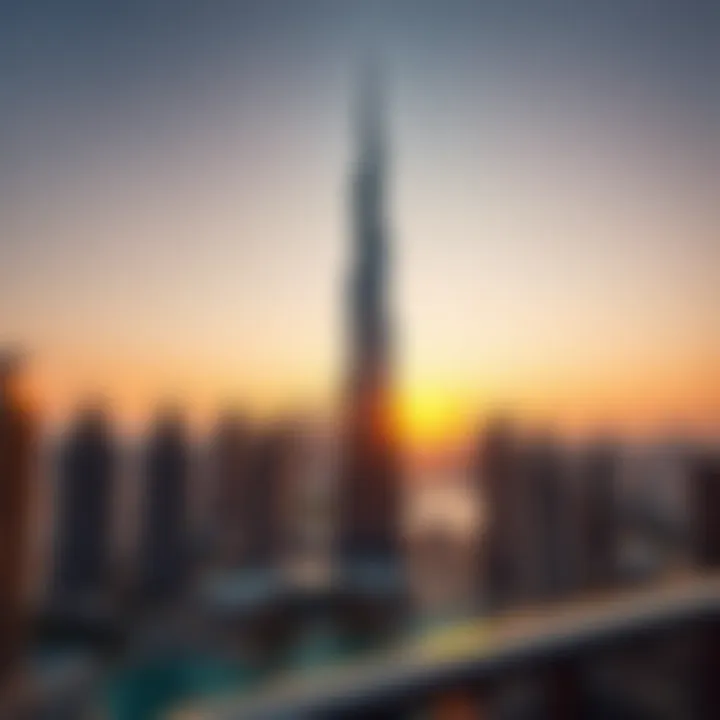
Intro
The Burj Khalifa stands tall over the skyline of Dubai, symbolizing more than just architectural prowess; it illustrates the ambition of a city that has transformed rapidly from a desert trading post into a global hub of commerce and tourism. As we embark on this deep dive into its grandeur, it is essential to understand its construction, the technological strides it represents, and the cultural tapestry woven around its existence.
Market Analysis
Current Trends and Insights
Dubai's real estate market remains as dynamic as ever, with properties surrounding the Burj Khalifa reflecting the trend of luxury and innovation that the tower epitomizes. Investors are keeping an eagle eye on trends that signal growth potential. Recent studies indicate that high-rise living, particularly in neighborhoods near iconic landmarks, is gaining traction. This desire feeds into the premium pricing associated with residences within a short distance of the Burj Khalifa.
Coupled with an influx of expatriates looking for opportunities, the demand for upscale living arrangements has risen. Rental yields in certain sectors adjacent to the Burj Khalifa have seen a surge, making these areas attractive for property developers and savvy investors alike. According to recent reports, properties within the Downtown Dubai district enjoy some of the highest occupancy rates in the emirate.
"The Burj Khalifa is no longer just a landmark; it’s an entire lifestyle and investment ecosystem."
Future Projections and Opportunities
Looking ahead, market analysts predict continued growth within the real estate sector surrounding the Burj Khalifa, driven by several factors. With the city's ongoing efforts to diversify the economy and promote tourism, the demand for both commercial and residential properties is expected to increase. Predictions indicate that rental values could further rise, particularly in high-end apartments and penthouses that boast incredible views of the cityscape.
Moreover, developments in infrastructure and transportation are set to bolster property values in the vicinity. New transport links are also being planned, making accessibility to the Burj Khalifa easier for residents and tourists alike. Expats considering relocation or investment opportunities would do well to keep their fingers on the pulse of these upcoming enhancements.
Lifestyle Considerations
Neighborhood Highlights
Living in the shadow of the Burj Khalifa offers a unique blend of excitement and sophistication. The surrounding areas are replete with vibrant dining, luxurious shopping, and picturesque parks that enhance the lifestyle of residents. Dubai Mall, a mammoth retail haven, is just a stone's throw away, providing residents access to high-end boutiques and exquisite dining experiences.
Additionally, the picturesque views provided by Burj Park offer a relaxing escape amidst the bustling urban life. This green space is perfect for leisurely walks or picnics with family and friends, allowing folks to unwind with a stunning backdrop.
Amenities and Services
Amenities around the Burj Khalifa are designed to cater to a varied but discerning demographic. From high-end fitness centers to five-star health clubs, residents have their pick when it comes to managing their wellness.
Services, too, are designed with convenience in mind. High-class concierge services, luxurious spas, and gourmet cuisine options meld together to create a lifestyle that is nothing short of opulent.
For expats, engaging in community activities is easy, thanks to the many cultural and social events frequently organized in the area. Social engagements allow newcomers to connect with others and integrate seamlessly into the vibrant community.
As we unravel the intricacies of the Burj Khalifa and its surrounding ecosystem, it becomes clear that this towering structure is more than a mere architectural feat. It is a thriving hub where lifestyle, investment, and culture converge.
Foreword to Burj Khalifa’s Distinctive Height
The Burj Khalifa stands tall as a symbol of human achievement, capturing the imagination of those who gaze upon its sleek silhouette against the Dubai skyline. This towering structure is more than just a building; it represents a convergence of architecture, engineering, and prestige that many aspire to reach. When discussing the importance of the Burj Khalifa's height, one must consider not just the numbers behind its remarkable stature but the broader implications it holds for urban development, tourism, and the perception of Dubai on a global stage.
Defining the Architectural Marvel
To fully grasp the significance of Burj Khalifa, one must probe into what qualifies it as an architectural marvel. Rising to a staggering 828 meters, the Burj is designed to evoke the shape of a desert flower. Its tapering design and sleek glass exterior reflect both modern aesthetics and functionality, maximizing natural light while minimizing heat absorption.
Key Features:
- Height: Dominating the list of tallest structures in the world, it has set a benchmark for skyscrapers.
- Design: The Y-shaped footprint enhances stability.
- Structural Materials: A combination of concrete and steel ensures durability and resilience against environmental challenges.
In essence, the Burj Khalifa isn't merely a high-rise; it's a testament to the capabilities of contemporary architecture. Investors and expatriates alike can appreciate how this building doesn't just house people or businesses—it creates a focal point for the entire city.
Global Recognition and Records
The global recognition of the Burj Khalifa is nothing less than breathtaking. This tower holds multiple records, including the title of the world's tallest building, a feat that has garnered attention from enthusiasts, investors, and tourists around the globe.
Highlighted Records Include:
- Tallest Structure - Previous heights have been dwarfed.
- Highest Observation Deck - Peering out from the 148th floor.
- Elevators - They ascend at mind-boggling speeds.
This recognition comes with its own set of societal dynamics. The Burj Khalifa has catalyzed a transformation in property values around its vicinity, drawing in investment and tourism like moths to a flame. In many ways, the tall building isn't just a geographical high point; it's an indication of Dubai's ambitions.
"Innovation is what drives Dubai forward, and the Burj Khalifa is its proud pinnacle."
When contemplating the Burj Khalifa, it becomes clear that its height is not merely a metric of inches or floors; it's a representation of how mankind envisions the future. For potential investors or anyone looking at the Dubai real estate market, understanding this towering achievement might just be the key to unlocking many opportunities.
Historical Background of Construction
Understanding the historical background of construction of the Burj Khalifa is vital for not just appreciating its design and scale, but also for grasping the entrepreneurial vision that spurred Dubai's rapid growth. This unique landmark stands tall as a testament to the aspirations of a city that transformed itself from a modest port into a bustling global hub. The construction timeline, the influences behind its design, and the various hurdles faced during its erection provide insights into the perseverance and innovation that define this architectural wonder.
Design Philosophy and Inspirations
The design philosophy behind the Burj Khalifa originated from both cultural and environmental considerations. The lead architect, Adrian Smith, drew inspiration from various sources, particularly the Islamic architecture prevalent in the region. The triangular footprint of the building mimics the shape of a desert flower, a nod to the natural beauty of its surroundings. This design suggests elegance while serving a practical purpose; the tapering form is optimized to withstand the strong winds typical in Dubai.

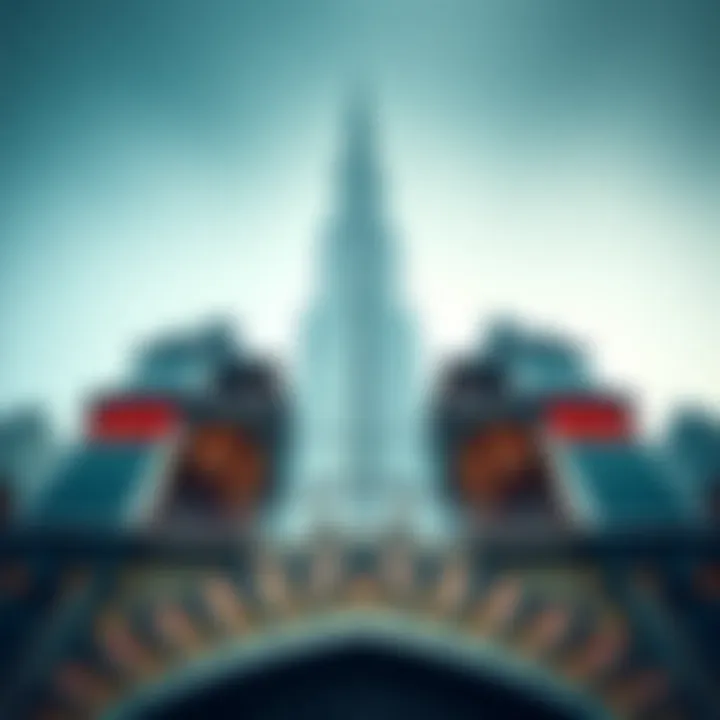
Notably, the building features a series of setbacks that not only contribute to its aesthetic appeal but also significantly enhance structural stability. Such clever intricacies highlight how cultural heritage, combined with modern engineering, informs architectural excellence. In a city known for its fusion of tradition and technology, Burj Khalifa stands as both an homage and a beacon of innovation.
Timeline from Groundbreaking to Completion
The journey to erecting the Burj Khalifa is one filled with ambition and rapid progress. Groundbreaking commenced in January 2004. By the end of that year, the initial structure had already begun to rise, setting a brisk pace for what was to come. Here's a snapshot of key milestones in its construction:
- 2004: Groundbreaking; excavation begins.
- 2005: Concrete core begins to rise, with major materials sourced from Asia and Europe.
- 2007: Burj Khalifa's height surpasses 500 meters, marking the midway point; it becomes a recognisable icon on Dubai's horizon.
- 2009: Topping out occurs at a staggering 828 meters; the building's final height is achieved by January 2010.
- 2010: Official opening on January 4, coinciding with Dubai's New Year celebrations.
It took six years from start to finish, a feat of engineering that challenged conventional building norms. The Burj Khalifa’s rapid ascent has set a new benchmark for future skyscrapers and demonstrated a profound commitment to architectural excellence. Through numerous trials, including adverse weather conditions and logistical challenges, the completion of Burj Khalifa in 2010 did not merely mark the end of construction; it heralded a new era in urban design and development for Dubai.
Architectural Features That Distinguish Burj Khalifa
The architectural features of the Burj Khalifa aren’t just a testament to human ingenuity; they represent a meticulous fusion of innovation, craftsmanship, and cultural symbolism. Each detail has been thoughtfully curated to not only sustain its colossal height but also to resonate with Dubai's aesthetic and ethos. The Burj Khalifa stands as a beacon of architectural prowess, drawing attentions not just for its height but for the story it narrates through its very design.
Innovative Design Elements
When we talk about innovative design elements in the Burj Khalifa, we step into a world where each curve and angle serves a purpose. The structure employs a unique triple-lobed footprint inspired by the Hymenocallis flower, which is not just visually striking, but also serves to stabilize the structure against the wind. This design choice is crucial, as Dubai’s wind patterns can be unpredictable and strong.
The tower tapers elegantly as it rises, allowing for less wind resistance as it approaches its pinnacle. Architect Adrian Smith, from Skidmore, Owings & Merrill, carefully crafted these contours to enhance both functionality and aesthetic.
Another noteworthy feature is the use of a buttressed core system. This structural technique allows the Burj Khalifa to achieve its unprecedented height while also providing the necessary stability. In a city known for both tradition and forward-thinking design, the Burj Khalifa symbolizes the best of both worlds.
"The Burj Khalifa doesn’t merely rise; it ascends as an idea, an aspiration."
Materials and Construction Techniques
The construction of the Burj Khalifa brought together some of the world's most advanced materials and construction techniques, making it a true marvel of modern architecture. A pivotal component is the reinforced concrete mixture used, which includes high-strength concrete capable of supporting the immense weight of the structure. Uniquely, the pouring of this concrete reached heights previously unrecorded in the industry, reflecting the tower's ambitious stature.
To combat the scorching heat of the Dubai sun, over 103,000 square meters of glass were used in the tower's facade. The glass panels were designed to reflect heat while allowing natural light to flood the interior spaces. Careful selection of these materials ensures that energy consumption remains efficient, aligning with sustainable building practices.
Additionally, the use of high-performance aluminum cladding mirrors the play of light throughout the day, subtly shifting in appearance from dawn to dusk. The construction techniques, including the use of a jump formwork system, helped expedite the building process while ensuring each segment was put in place securely.
Height: A Numerical Perspective
Understanding the significance of height in the context of Burj Khalifa goes beyond mere numbers. This tall structure isn't just a record-breaker; it encapsulates the very essence of ambition and innovation that defines Dubai. Height, when viewed from a numerical perspective, also brings numerous benefits while presenting certain considerations. The Burj Khalifa stands at an impressive 828 meters, making it the tallest building in the world since its completion in 2010. This remarkable height not only awes visitors and locals alike but also acts as a magnet, drawing tourists and professionals to Dubai.
Beyond the aesthetic impact, the height contributes substantially to the economic landscape. Investors see it as a symbol of the emirate's capability to host high-profile businesses and events. Moreover, it pushes the boundaries of construction technology, forcing engineers and architects to rethink what is possible. This drive for vertical expansion fosters innovation, paving the way for future skyscrapers and developments worldwide.
Measuring the Burj Khalifa
To put into perspective how Burj Khalifa is measured, one should look at both architectural and structural heights. Architectural height refers to the total height from the ground level to the architectural top, while structural height includes spires but not antennas. The Burj Khalifa's impressive height is measured using architectural standards, giving it an official height of 828 meters. However, that number can take on a life of its own, especially when pulled into comparisons with its global counterparts.
In practical terms, the height of Burj Khalifa can be expressed in various relatable ways: 2,717 feet, approximately 100 stories tall, or even enough to stack more than two Eiffel Towers on one another. This measurement presents an intuitive sense for many, translating a purely numerical construct into relatable terms for the everyday individual.
"Every inch of Burj Khalifa tells a story of architectural triumph, pushing the limits of human ingenuity."
Comparison with Other Tall Structures
When one starts comparing Burj Khalifa to other skyscrapers, the numbers can be staggering. For instance, the Shanghai Tower, which stands at 632 meters, pales when placed next to Dubai's crowning glory. The One World Trade Center in New York reaches 541 meters, and the Petronas Towers in Malaysia are at a modest 452 meters, if one can call it modest in such a lofty context.
- Burj Khalifa: 828 meters
- Shanghai Tower: 632 meters
- One World Trade Center: 541 meters
- Petronas Towers: 452 meters
This hierarchy not only reflects the physical superiority of Burj Khalifa but also highlights the aspirations behind each construction project. With each subsequent building, cities strive to surpass the previous achievements, creating a race that has led to modern marvels of engineering.
The Burj Khalifa stands, therefore, not just as a building, but as a definitive marker in architectural history. It inspires ongoing conversation around the potential of urban landscapes and ultimately embodies the spirit of innovation that has come to define Dubai's skyline.
Technological Innovations in Construction
The Burj Khalifa stands not just as a testament to human ingenuity, but also as a showcase of advanced technologies that redefine construction practices. In exploring its architectural excellence, one cannot overlook the critical role of technological innovations in this monumental endeavor. These technologies not only helped bring visions to life but also redefined what is conceivable in high-rise constructions.
Engineering Marvels Utilized
At the core of the construction of Burj Khalifa were several groundbreaking engineering advancements. The building employed a super-strong concrete mix, designed specifically to withstand the pressures imposed by its unprecedented height. This concrete was formulated to be both lightweight and robust, achieving a compressive strength of more than 120 megapascals.
Moreover, a unique 'buttressed core' structural system was utilized. This approach consisted of a central core with three wings that form a Y shape, offering greater stability against wind forces. The design functions like a tree with trunk and branches, gracefully distributing any stress as the building sways gently under the pressure of strong winds.
An essential technological marvel was the use of high-capacity cranes. They were specifically engineered to operate at significant heights and could lift weights of up to 25 tons. This allowed the assembly of materials with remarkable efficiency; thus, salvaging both time and resources during the building process.
"The Burj Khalifa doesn’t just scrape the sky; it redefines it with engineering techniques that challenge the norm."
Sustainable Building Practices
Sustainability has emerged as a non-negotiable aspect of modern construction, and the Burj Khalifa is no exception. Its design incorporates features that significantly reduce energy consumption and resource use.
One notable innovation is its advanced energy efficiency system. The building is equipped with a centralized control system that optimizes the performance of lighting, heating, and cooling systems. As a result, energy expenditures are minimized, allowing the structure to adapt to the needs of its occupants more efficiently.
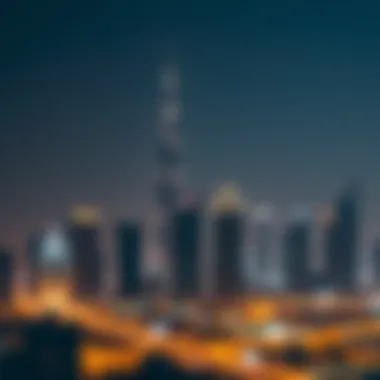

Additionally, the use of reflective glass plays a pivotal role in thermal regulation. This special glazing reduces heat gain while ensuring that the interiors remain well-lit, creating a pleasant work and living environment without excessive reliance on artificial lighting or heating.
Rainwater harvesting systems have also been integrated. Capturing and reusing rainwater signifies a leap towards sustainability in a region where water scarcity is a pressing concern. This harvested water is utilized for landscaping and other non-potable purposes, embodying a step toward ecological consciousness.
The innovation doesn’t stop there. Solar panels installed on rooftops contribute to the building's energy needs, cutting down on reliance on nonrenewable resources. Each of these practices marks a progressive shift toward sustainable urban environments, making Burj Khalifa not just a towering wonder, but a model for future constructions.
Cultural and Economic Impact on Dubai
The Burj Khalifa stands tall, not only as an architectural wonder but also as a powerful symbol of Dubai’s ambition and growth. Understanding its cultural and economic implications helps paint a vivid picture of how it reshapes the landscape, both literally and metaphorically. This section explores two key elements: its symbolism within the city's identity and the boost it provides to tourism and real estate markets.
Symbolism of Burj Khalifa in Dubai
The Burj Khalifa, soaring at 828 meters, showcases Dubai’s grit and determination to carve out its place on the world stage. The building is more than just a tall structure; it symbolizes the spirit of innovation and the quest for excellence. Its unique design, inspired by Islamic architecture and local culture, reflects a deep-rooted heritage and respect for tradition, all while pushing the envelope of modern engineering.
People often see the Burj Khalifa as a beacon of hope and a testament to human achievement. It draws visitors from all corners of the globe, serving as a melting pot of cultures, ideas, and aspirations. As the sun sets behind it, illuminating its exterior with a golden glow, one can't help but feel a sense of pride that resonates in the hearts of Dubai's residents. The skyline is forever transformed, telling the tale of a city that refuses to settle for the ordinary.
“The Burj Khalifa is not just a building; it is a movement. It shows what can happen when innovation meets ambition.”
In local culture, the Burj Khalifa represents Dubai's resilience, especially during economic challenges. It stands as a reminder that through adversity, the city can rise, much like its tallest structure. The message resonates deeply—when you aim high, all things are possible.
Boost to Tourism and Real Estate
The economic impact of the Burj Khalifa on Dubai cannot be overstated. Since its completion, the tower has become a tourist hotspot, attracting millions of visitors each year. The allure of standing on its observation decks offers breathtaking views of both the city and the vast Arabian Gulf. As an integral part of the larger Downtown Dubai development, it has catalyzed an influx of tourists seeking experiences that blend luxury with culture.
Key benefits:
- Increase in Visitor Numbers: The Burj Khalifa aids in drawing approximately 1.87 million visitors annually to its observation decks alone, enhancing Dubai’s status as a global tourism hub.
- Impact on Hospitality Sector: The surrounding area is home to luxury hotels and restaurants, which thrive on the traffic generated by the Burj Khalifa, creating countless jobs.
- Real Estate Development: The attraction has led to skyrocketing real estate values in the vicinity. Properties near the Burj Khalifa command premium prices, driving investment interests from global investors and expatriates alike.
Real estate agents and developers have taken note, employing strategies to meet the demand for properties that offer unobstructed views of this iconic tower. As such, it has become a focal point in marketing campaigns targeting affluent investors from around the world.
Urban Development Measurement
Urban development measurement is a crucial aspect when discussing landmarks like the Burj Khalifa. This measurement doesn’t just quantify the physical space but serves as a reflection of how these towering structures reshape their environments. The Burj Khalifa stands not only as a symbol of architectural prowess but also as a catalyst for urban evolution in Dubai. The significance of this topic intersects various spheres, including economic, social, and cultural dimensions.
- Economic Growth: With the presence of such a monumental structure, surrounding areas have undergone significant transformation. The Burj Khalifa has spurred investment and infrastructure development, attracting both local and foreign investors. This investment leads to job creation and improves the overall economic landscape of the region.
- Social Implications: Higher edifices often bring people together. The development around the Burj Khalifa has fostered community spaces where individuals from diverse backgrounds meet. This integration creates a socio-cultural tapestry, rich in interactions and shared experiences.
- Architectural Standards: Building around such an icon sets a benchmark. Those involved in urban planning and construction must now consider how new developments harmonize with the existing skyline and public spaces. This affects everything from zoning laws to design aesthetics, ensuring a balance between progress and heritage.
Influence on Surrounding Neighborhoods
The influence of Burj Khalifa extends well beyond its immediate vicinity. Surrounding neighborhoods have experienced a renaissance since the tower's construction. Significant growth in residential and commercial real estate has been observed, fundamentally altering their character.
- Gentrification: Areas such as Downtown Dubai have witnessed an influx of affluent residents and businesses. This gentrification has led to higher property values and rents, impacting long-time inhabitants. While beneficial in some regards, it raises questions about social equity and accessibility.
- Urban Amenities: The Burj Khalifa’s construction has catalyzed the development of essential services. Parks, cafes, and retail venues have emerged, enhancing the quality of life for residents. Investors recognize the rising demand for these amenities, leading to a healthy market for retail businesses and service providers.
"Neighborhoods surrounding great structures often evolve in ways that reflect both the aspirations and concerns of their communities."
Integration into Dubai's Urban Fabric
The seamless integration of Burj Khalifa into Dubai's urban fabric represents a sophisticated balancing act of tradition and modernity. It’s essential to understand how this iconic structure has influenced not just the skyline, but the planning and functionality of the city itself.
- Public Transit Enhancement: With increased foot traffic resulting from the Burj Khalifa, public transportation systems have improved. The addition of a new metro line and enhanced bus routes ensures that visitors and residents have reliable access to the tower and surrounding areas.
- Sustainability Initiatives: Urban planners have integrated green spaces and sustainable systems around the tower. Initiatives such as rainwater harvesting and waste recycling are now part of the urban development narrative. This shift reflects a growing trend in city planning where sustainability is a core value.
The Burj Khalifa does not merely stand tall; it transcends its physical form to become a significant lever in urban development, influencing how cities are conceived, built, and lived in, providing insights for investors and expatriates alike.
Visitor Experience and Interaction
The Burj Khalifa stands not only as a skyscraper but also as a symbol of human aspiration and architectural ingenuity. It draws millions of visitors every year, providing them with a unique blend of breathtaking views and an immersive cultural experience. From tourists snapping selfies against the towering backdrop to expatriates seeking a taste of luxury, the experience inside the Burj Khalifa unfolds as a tapestry of interactions and emotions.
Observation Decks and Features
The Observation Decks of the Burj Khalifa are probably among the most talked-about features of this marvel. At the 124th and 148th floors, visitors are treated to panoramic views of Dubai and beyond. To say it offers a different perspective would be an understatement; it gives visitors a chance to see the world from the clouds, where buildings look like toys and the Arabian Gulf stretches infinitely into the horizon.
What actually makes the decks special, however, are the thoughtful design elements. There are glass panels that allow for unobstructed views, audio guides filled with engaging information about what one can see from up there, and well-trained staff to assist visitors. A trip to the Burj Khalifa's observation deck isn’t just about the height; it’s about education and engagement. You can look out over the city and hear the bustling tales of its rapid transformation right from professionals who help maintain the narrative.
Key Features:
- High-speed elevators: Traveling upwards at speeds of up to 10 meters per second.
- Interactive displays: Learn about key landmarks and their significance in real-time.
- Seating areas: For those who want to just sit and soak in the view without any rush.
As you ascend, the excitement builds, but so does the wonder. Those few minutes in the elevator – with a stunning light show accompanying the swift ascent – set the tone, wrapping visitors in anticipation.
Art and Exhibits Inside the Burj
Walking through the Burj Khalifa is akin to meandering through a gallery of modern art that speaks of both history and future. Art installations from various artists, including local talent, enhance the overall ambiance of the building. The exhibits reflect the rich heritage of Dubai and its culturally vibrant society.
Inside the building, you'll find pieces that not only capture the essence of the UAE’s narrative but also emphasize contemporary perspectives. Some areas are adorned with intricate designs inspired by Islamic art, while others showcase the fusion of modern themes with traditional aesthetics. Visitors are often stunned by the blend of technology and artistry that livens the space.
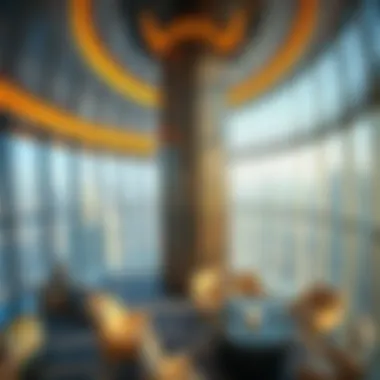
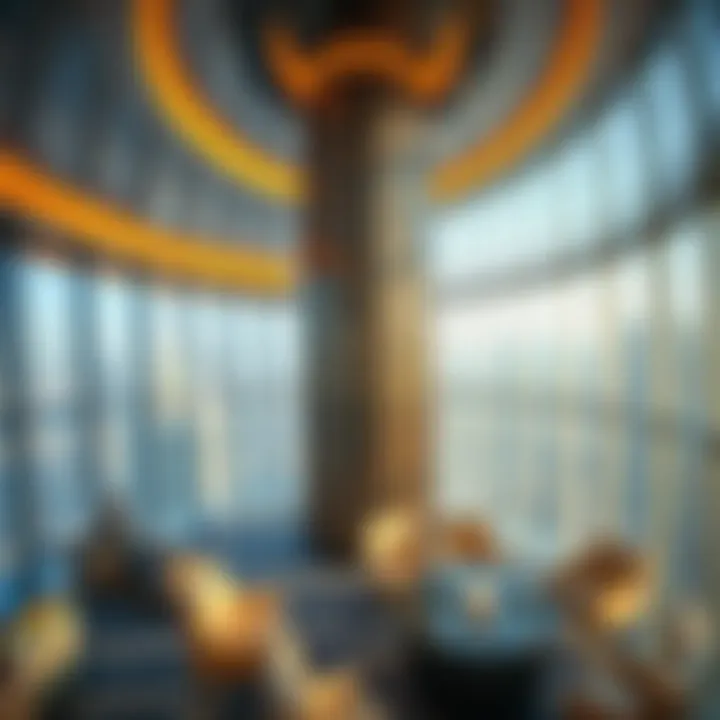
Various art sections are curated in a way that inspires thought while engaging the senses.
- Sculpture Displays: Artwork often includes sculptures made from varied materials, symbolizing different cultural stories.
- Photographic Exhibits: Showcasing Dubai’s journey from a humble fishing village to a global city.
- Cultural Installations: Interactive art pieces that require visitor participation to install the narrative fully.
These elements ensure that the Burj Khalifa is more than just a tall building, but rather, a hub of culture, creativity, and inspiration.
"The Burj Khalifa teaches visitors about the Arab heritage while looking towards the future. It's an enriching journey on both a personal and cultural level."
In summary, the visitor experience and interaction with the Burj Khalifa are not just about witnessing the physical height of the building; they embody an overarching journey through innovation, culture, and architecture that leaves a significant mark on anyone who steps inside.
Burj Khalifa in Popular Culture
The Burj Khalifa, dominating the Dubai skyline, is much more than a gargantuan structure; it is a cultural icon. Its role in popular culture is vast, reaching across different forms of media and captivating audiences worldwide. For investors and expatriates alike, understanding this cultural prominence is crucial because it directly influences tourism and local engagement around Dubai.
Cinematic Presence
Whenever a film desires to convey luxury, progress, or sheer opulence, filmmakers often turn their cameras toward the Burj Khalifa. The iconic building has appeared in various high-profile movies, creating scenes that resonate with audiences beyond the UAE. For instance, in the movie Mission: Impossible – Ghost Protocol, Tom Cruise famously scaled its exterior, showcasing not just his character's fearlessness but also the majestic structure itself. This thrilling sequence not only captivated moviegoers but ingrained the Burj Khalifa into the collective consciousness of global cinema lovers.
Moreover, international blockbusters frequently utilize the tower as a backdrop or symbolic representation of modern architecture, sophistication, and human achievement. This recurrent appearance generates interest, drawing travelers and thrill-seekers from afar who wish to see for themselves what they’ve only glimpsed on screen.
As various filmmakers spotlight the Burj Khalifa, they assert its significance as a beacon of innovation, compelling viewers to experience Dubai's dazzling urban essence.
Media Representation and Impact
The media has given substantial attention to the Burj Khalifa, highlighting it as a symbol of Dubai’s rapid growth and ambitious vision. Various news outlets, including National Geographic and the BBC, have dedicated segments to this towering marvel, discussing its engineering feats, cultural impact, and economic implications. The media portrayal goes beyond mere visuals; it often delves into narratives surrounding its construction and the aspirations it represents for the people of Dubai.
However, representation isn't always positive. Critiques occasionally arise regarding the environmental impacts and the grandiose spending that the Burj Khalifa signifies in a region that still grapples with various socio-economic challenges. This duality in media commentary allows for rich discussions about the complexities and consequences of urban marvels, pushing the narrative beyond superficial glamour.
In Summary
Future Prospects for Burj Khalifa and Dubai
When we look at the towering Burj Khalifa, it's easy to see it as simply an architectural wonder. However, its future prospects are crucial to not just its own legacy, but also the trajectory of Dubai itself. As the tallest structure in the world, the Burj Khalifa stands as a beacon of innovation and ambition. The path ahead is filled with both challenges and opportunities that can redefine its role in a rapidly evolving urban landscape.
Ongoing Maintenance and Renovations
Maintaining a giant like the Burj Khalifa is no small feat. Ongoing upkeep involves not just routine cleaning to keep that iconic facade shining, but structural inspections to ensure safety and longevity. The process is meticulous; at 828 meters high, even the simplest task requires planning and coordination.
- Regular inspections are vital and consist of checking the glass panels and steel framework. This helps in early detection of wear and tear.
- Cleaning is performed by specialized teams that dangle from harnesses, doing their best not to disturb the skyline's majesty.
Technologically advanced materials and techniques help in reducing maintenance costs over the long run. As Dubai grows, the building adapts, ensuring that it holds its position as an attraction for tourists and a residence for high-profile individuals. Renovations also play a key role here, infused with the latest smart technologies. For example, smart elevators and energy-efficient systems minimize operational costs and enhance user experience.
The ongoing efforts in maintenance depict a clear understanding that even idols require care. The Burj Khalifa doesn't just symbolize height; it represents resilience and dedication.
Role in Future Urban Planning
The Burj Khalifa is more than just a tall structure; it's a harbinger for future urban planning in Dubai. Its influence can be seen rippling through surrounding developments. In the years ahead, it may guide strategies for maximizing space and integrating nature within a pulsating urban environment. Here are some insights into its envisioned role:
- Urban Density Enhancements: The success of this skyscraper is setting an example for vertical living where space is at a premium. Following its blueprint, future skyscrapers might also aim for higher and more efficient designs.
- Smart City Integration: With the rise of smart technology, it’s expected that the surrounding areas will increasingly incorporate IoT solutions, making the Burj Khalifa a pivot for these urban innovations.
- Cultural Revitalization: The building is a cornerstone in creating a cultural hub. Future projects may aim to blend residential, commercial, and leisure spaces, fostering a sense of community among expatriates and locals alike.
As urban dynamics change, the Burj Khalifa's continued importance within Dubai's skyline serves not only as a marvel of architecture but as a pillar for future developments. How it adapts and influences urban planning will matter significantly, shaping the city for generations to come.
Closure: The Enduring Legacy of Burj Khalifa
The Burj Khalifa stands not merely as a marvel of engineering but as a profound symbol of ambition and innovation that has left an indelible mark on the landscape of architecture. Its towering height commands respect and admiration from all corners of the globe. In this conclusion, it is essential to reflect on the multifaceted significance of this monumental structure and how it sets a precedent for future developments.
One primary aspect to consider is its role in shaping Dubai's identity. The Burj Khalifa encapsulates the city’s rapid transformation from a modest trading port to a global metropolis. This skyscraper has become synonymous with the brand of Dubai, a testament to what is possible when vision is paired with relentless determination.
- Symbolism of Hope: The Burj Khalifa represents not just a building, but the aspirations of a nation. It showcases the power of human imagination and resourcefulness, inviting investors to envision possibilities that extend beyond what seems feasible.
- Benchmark for Future Projects: It has set a benchmark in the field of architecture and urban development. With a variety of techniques and materials employed, it encourages architects and builders worldwide to push their boundaries, aiming for not just height but also sustainability and innovation.
In essence, the Burj Khalifa serves as an ongoing lesson in ambition, creating dialogue about what the future might hold. The legacy of this iconic structure is more than mere bricks and mortar; it’s about ambition, creativity, and change that resonates with global audiences.
Reflection on Architectural Significance
The architectural significance of the Burj Khalifa cannot be overstated. It is an emblem of advanced engineering and a showcase of architectural mastery. The design, conceived by the renowned firm Skidmore, Owings & Merrill, effectively merges Islamic aesthetic principles with modern technology. By utilizing buttressed core structures, the building achieves both stability and height, making it a defining feature of contemporary architecture.
- Innovative Design: The Y-shaped floor plan not only optimizes the view but also curtails wind forces acting on the structure, a critical factor for towering edifices.
- Cultural Influence: The inclusion of traditional elements within a modern framework reflects a deep respect for heritage while embracing modernity, illustrating a unique blend of old and new.
This narrative of architectural significance further extends into discussions about sustainability and smart technology integration, ensuring that future generations can admire and learn from this wonder.
The Future of Tall Structures
Looking ahead, the future of tall structures is set to evolve dramatically, influenced by innovations sparked by the Burj Khalifa. As cities grow, the demand for height will likely increase, spurring creative designs that adapt to urban challenges.
- Technological Advancements: New construction technologies and materials will redefine how skyscrapers are conceptualized, focusing on energy efficiency and minimal ecological impact.
- Height vs. Sustainability: As the push for sustainability intensifies, future skyscrapers are expected to integrate green features, such as vertical gardens and smart energy systems, to reduce their carbon footprint while enhancing urban livability.
Investors, agents, and expatriates should keep a keen eye on emerging trends within this realm, as the evolution of height in architecture will continue to shape not just skylines, but also economies and lifestyles in urban settings.
"The Burj Khalifa’s impact extends beyond its height; it redefines skyline aspirations, signaling to the world that the sky is not the limit but merely the beginning."
As we conclude, it becomes evident that the Burj Khalifa is not just a physical milestone but a beacon of what can be achieved through vision and dedication, paving the way for future tall structures that aspire to tell their own stories in a rapidly changing world.











